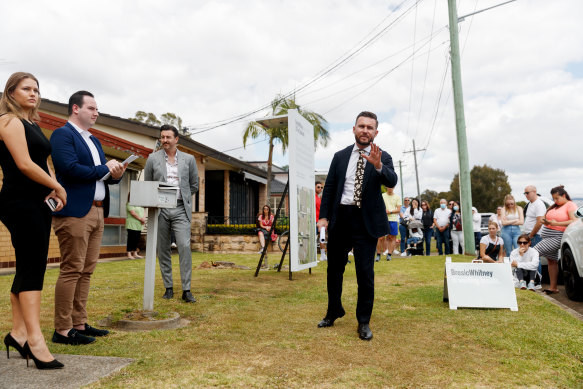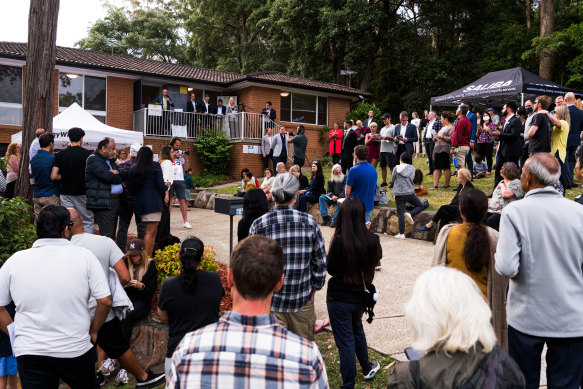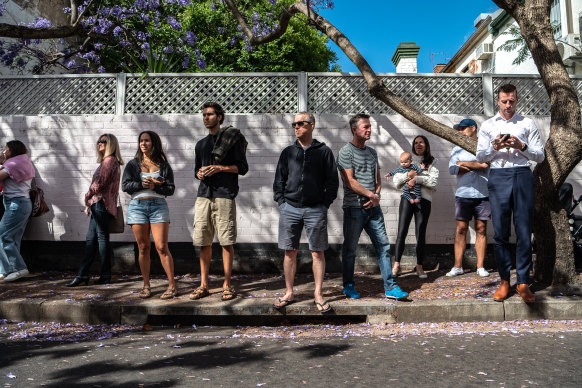This was published 5 months ago
The Sydney suburbs where homeowners can’t pay their mortgages
By Tawar Razaghi and Jim Malo
More homeowners are falling behind on mortgage repayments in Sydney’s low- to middle-income suburbs where wages have failed to keep pace with rising interest rates and the increased cost of living.
As many as 500 households across NSW could fall behind on repayments for every extra 25 basis point increase from here, credit bureau illion forecasts.

Home loan repayments have soared. Credit: Nikki Short
In Sydney, 0.63 per cent of home loans were more than 30 days overdue by December, data from illion found.
That’s likely to rise to 0.66 per cent if there is another 25 basis point rate rise, illion forecasts, and will reach 0.69 per cent after a second rate rise.
So far, western and south-western Sydney suburbs are most likely to have fallen behind on mortgage repayments. Suburbs that top the list include Mount Vernon, Old Guildford, Shalvey and South Granville, where between 2.2 per cent and 2.5 per cent of loans are behind.
Ahead of the Reserve Bank’s interest rate decision on Tuesday, when another hike is expected, illion head of modelling Barrett Hasseldine said the number of households falling behind on mortgage repayments has been on the rise for four months.
“From September to December, we’ve seen the portion of home loans that are behind on their repayments increase every one of those months.”
Illion tracks whether home loans are behind or not based on monthly updates on credit accounts, such as home loans, provided by major lenders.
The main reason driving delinquency rates, Hasseldine said, was wages failing to keep up with the rapidly rising cost of living and interest rates at the same time that many households had whittled down COVID-era savings buffers.
“This puts a lot of pressure on everyone but most of all it puts pressure on households that don’t have a monthly surplus of household income,” he said.

Mid- to low-socioeconomic areas have fallen behind on mortgage repayments more than other parts of Sydney.Credit: James Brickwood
This includes households in mid- to lower-socioeconomic regions and households who took out a new home loan or refinanced to their maximum borrowing capacity during the COVID-19 pandemic, he said.
Those who did take out a new loan or refinanced in the past two years were stress tested to see if they could still repay loans if rates rose by 3 per cent, and have eroded that buffer since rates have increased by that amount already, Hasseldine said.
Home borrowers have been busily refinancing to deal with rising rates, and the value of housing refinancing hit $19.1 billion in December, ABS figures showed, second only to the all-time high the previous month.
“Inflation is still very high, so we expect we will see further rate rises which will exacerbate the financial pressures we’re seeing already.

Illion forecasts that more households will fall behind mortgage repayments as rates continue to rise this year.Credit: Flavio Brancaleone
“We’ve been tracking consumer savings and have seen that, while there were lots of savings during lockdown, for many people that savings are exhausted and so it’s likely that future rate rises are going to see all areas worsening in repayments. But it will be most exacerbated in homes in mid-to-lower socioeconomic regions.”
He said younger Australians who bought their first home earlier in the pandemic would feel the pinch, as would regional areas.
“The effects of climate may exacerbate the pressure on regional households,” he said, adding that flood-affected regions were going to be hardest hit.
The fixed-rate cliff was another factor that would drive delinquency rates higher, leaving no suburb immune to rising rates, he said.
AMP Capital chief economist Shane Oliver said it was likely regional suburbs and city-fringe areas would have the highest rates of mortgage delinquency.
“The problem in those areas is there was a boom in first-home buying during the pandemic,” he said.
“The low deposit schemes enabled people to get in [to the property market] when they probably couldn’t, which is probably coming home to roost now.”
Regional areas have lower income levels than the cities and less job security, leaving them a little more vulnerable, he said.
Insecure work and lower incomes meant some households wouldn’t have a savings buffer to protect them from rate rises, Oliver said.
“People in higher- and middle-income suburbs tend to be more financially secure even if they have mortgages,” he said.
“They tend to have more stable income flows and bigger savings buffers. The data would suggest the bulk of that saving occurred with higher income, older people.”
Mortgage Choice Blaxland, Penrith and Glenmore Park principal and broker Rob Lees said while he has yet to see any client behind on mortgage repayments, households across the board are deeply worried.
“They’re worried, and they’re not sure how they’ll be able to manage it. That is the prevailing mood,” Lees said.
He agreed the fixed-rate cliff was going to test most mortgage holders.
“Some people are going from rates of 1.99 per cent to 6 per cent,” he said. “If you’ve got a million dollar loan, and you’re locked in 2 per cent, interest goes from $20,000 to $60,000 a year, that’s massive.”